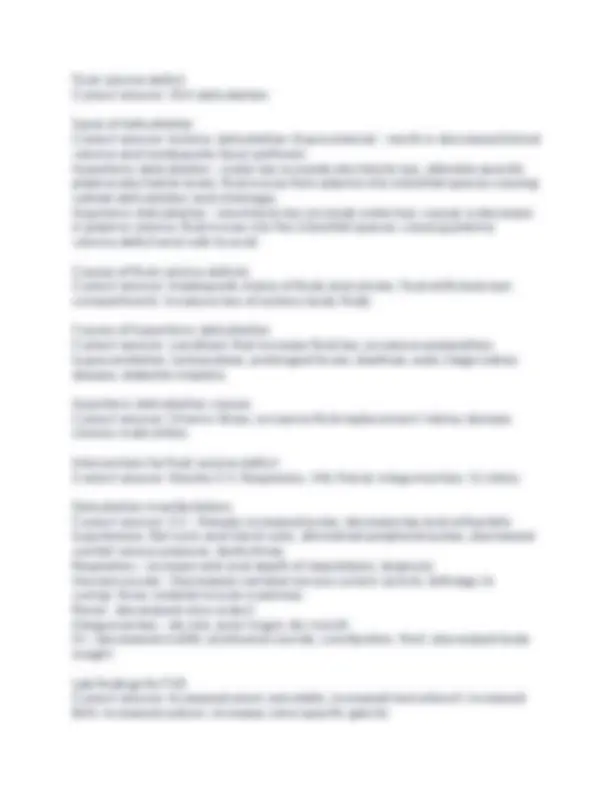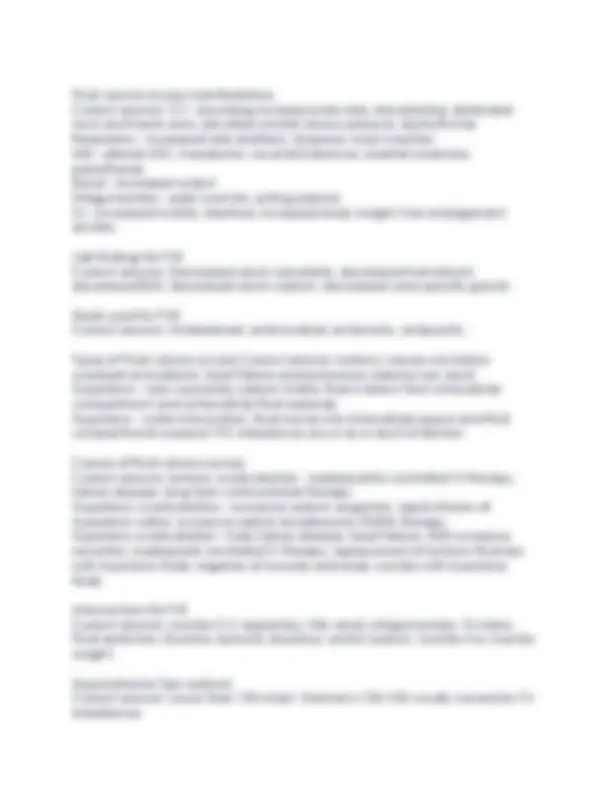





Study with the several resources on Docsity

Earn points by helping other students or get them with a premium plan


Prepare for your exams
Study with the several resources on Docsity

Earn points to download
Earn points by helping other students or get them with a premium plan
Community
Ask the community for help and clear up your study doubts
Discover the best universities in your country according to Docsity users
Free resources
Download our free guides on studying techniques, anxiety management strategies, and thesis advice from Docsity tutors
A comprehensive overview of the key topics and concepts that nursing students should focus on when preparing for the hesi fundamentals exam. It covers a wide range of subjects, including fluid and electrolyte balance, acid-base balance, laboratory values, nutrition, intravenous therapy, and blood administration. The document also discusses the importance of understanding fluid and electrolyte imbalances, their causes, and the appropriate interventions. Additionally, it covers topics such as osmotic pressure, hydrostatic pressure, and the role of various organs in maintaining fluid balance. A valuable resource for nursing students who are preparing for the hesi fundamentals exam, as it provides detailed information and practical tips to help them succeed.
Typology: Exams
1 / 5

This page cannot be seen from the preview
Don't miss anything!




For Nursing Science focus on what? Correct answer- F+E, ABGs, Lab values, Nutrition, IV therapy, blood administration, What to focus on when there is an ABGs and F+E imbalance? Correct answer- Patent airway, ABGs, VS, CV and Neuro status, Lab values, I+Os. Think of dx and affected organs. Nutrition cheats, focus on what? Correct answer- Think of dx, and nutrition restriction or requirements. Focus on what for IV therapy? Correct answer- Allergies (latex, plastic, drug) Focus on what for blood transfusions? Correct answer- Reactions and appropriate interventions. Who is at greatest risk for fluid imbalance? Correct answer- Infants and older adults, fluid constitutes 80% and 55% of weight for each, so fluid imbalance will have a greater impact. F+E cheat tips! Correct answer- Remember that for every cation, there is an anion. When one substance moves out of a space, another substance has to take its place to keep balance. Osmotic pressure Correct answer- Draws water through a semi permeable membrane to a more concentrated side, or a side with more solute. Hydrostatic pressure Correct answer- Force exerted by weight of a solution. When a difference occurs, water and diffusable solutes move out of the solution by filtration. At the arterial end of the capillary is the pressure higher or lower than osmotic pressure? Correct answer- Higher - fluids move out of the capillary.
At the venous end, is the osmotic pressure higher or lower than the osmotic pressure? Correct answer- Higher, fluids move into the capillary. Excess fluid and solutes remaining in the interstital spaces are returned where? Correct answer- to the intravascular compartment by the lymph channels. Osmolarity Correct answer- number of osmotically active paricles per kilogram of water, concentration of a solution. Measured in milliosmoles (mOsm). Osmolarity of plasma is Correct answer- 270 - 300 mOsm/kg of water. Substances that require active transport? Correct answer- Sodium, potassium, calcium, iron, hydrogen, sugars, amino acids. WAter lost through skin Correct answer- insensible loss. Average amount of loss by perspiration Correct answer- 100mL/day. Fluid intake Correct answer- INgested water 1200-1500mL Ingested food 800-1100mL Metabolic oxidation 300mL. Total 2300-2900mL Fluid output Correct answer- Kidneys 1500 mL Insensible loss through skin 600-800mL INsensible loss through lungs 400-600mL GI Tract 100mL Total - 2600 - 3000mL Client at high risk for f + e imbalance? Correct answer- Diarrhea Organs involved in fluid balance maintenence Correct answer- Kidneys, Adrenal glads (thyroid, parathyroid), hormone aldosterone (regulates amount of sodium absorbed by kidney). ADH from pituitary. (regulates amount of water reabsorbed by kidney.)
Fluid volume excess manifestations Correct answer- CV - bounding increase pulse rate, elevated bp, distended neck and hand veins, elevated central venous pressure, dysrhythmias. Respiratory - Increased rate (shallow), dyspnea, moist crackles. NM - altered LOC, headache, visual disturbances, skeletal weakness, paresthesias. Renal - increased output. INtegumentary - pale cool skin, pitting edema. GI - Increased motility, diarrhea, increased body weight, liver enlargement, ascities, Lab findings for FVE Correct answer- Decreased serum osmolarity, decreased hematocrit, decreased BUN, decreased serum sodium, decreased urine specific gravity. Meds used for FVD Correct answer- Antidiarrheal, antimicrobial, antiemetic, antipyretic. Types of Fluid volume excess Correct answer- Isotonic causes circulatory overload and edema. heart failure and pulmonary edema can result. Hypertonic - rare caused by sodium intake, fluid is drawn from intracellular compartment and extracellular fluid expands. Hypotonic - water intoxication. fluid moves into intracellular space and fluid compartments expand. F+E imbalances occur as a result of dilution. Causes of fluid volume excess Correct answer- Isotonic overhydration - inadequately controlled IV therapy, kidney disease, long term corticosteroid therapy. Hypertonic overhydration - excessive sodium engestion. rapid infusion of hypertonic saline. excessive sodium bicarbonate (TUMS) therapy. Hypotonic overhydration - Early kidney disease, heart failure, ADH excessive secretion, inadequate controlled IV therapy, replacement of isotonic fluid loss with hypotonic fluids, irrigation of wounds and body cavities with hypotonic fluids. Interventions for FVE Correct answer- monitor CV, respiratory, NM, renal, integumentary, GI status. Fluid restriction, Diuretics (osmotic diuretics), restrict sodium, monitor i+o, monitor weight. Hyponatremia (low sodium) Correct answer- Lower than 135 mEq/l. (Normal is 135-145) usually caused by FV imbalances.
Hyponatremia causes Correct answer- Excessive diaphoresis, diuretics, vomitting, diarrhea, wound drainage, kidney disease. Decreased aldosterone. Inadequate sodium intake. Excessive ingestion of hypotonic fluid, freshwater drowning, hyperglycemia, heart failure. Hyponatremia interventions Correct answer- monitor, IV sodium chloride infusion, osmotic diuretics.